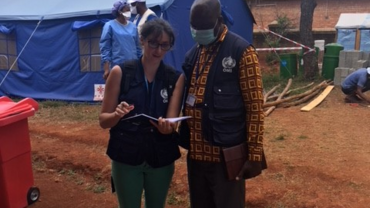Plague - Annual Epidemiological Report 2016 [2014 data]
No cases of plague were reported in EU/EEA countries in 2014.
Download
Methods
Click here for a detailed description of the methods used to produce this annual report
• Data were obtained from 30 EU/EEA countries.
• The EU case definition was used by 24 countries. Three countries used an alternative case definition (Denmark, Germany and Italy), and a further three countries did not specify the case definition (Belgium, Finland and France).
• Surveillance is compulsory in 29 EU/EEA countries (except in the United Kingdom), comprehensive, mostly passive, and data reporting is case based (Annex).
Epidemiology
No cases of plague were reported in EU/EEA countries in 2014.
Discussion
Plague, caused by the bacterium Yersinia pestis, is enzootic in wild rodents in central and eastern Asia, Africa, and North America, and remains endemic in many natural foci around the world. Recent outbreaks have shown that plague may reoccur in areas that have long remained unaffected. Humans can be infected through 1) the bite of an infected flea carried by a rodent or, rarely, other animals, 2) direct contact with contaminated tissues, or 3) in rare cases, inhalation of respiratory secretions from infected persons or animals [1]. Untreated plague, particularly the pneumonic form, is often fatal. While urban plague has been controlled in most of the world, it remains a public health problem in rural areas in many countries.
Autochthonous plague has not occurred in Europe for several decades.
Worldwide, the country that reported most of the cases of plague in 2014 (482 cases) was Madagascar where Y. pestis remains endemic. During the 2014–2015 season (August to April) in Madagascar, 308 cases were reported, including 81 deaths (case–fatality ratio: 27%). Cases were also reported in the capital city of Antananarivo. An important concern is the rise of resistance of fleas to insecticide [2].
In 2014, the USA reported a total of 10 cases (no deaths) [3]; from April to August 2015, 11 cases (three deaths) were reported [4].
The African countries (especially Democratic Republic of Congo and Madagascar) represented more than 97% of infections worldwide during 2000–2009 [5]. Plague may reoccur in areas that have long remained unaffected as shown in 2003 in a rural area south of Oran, Algeria [6], or in 2008 in the Laghouat area, Algeria, which was not previously known as a plague focus [7]. In Libya, the disease reoccurred near Tobruk in 2009, after 25 years without cases [8]. Another unconfirmed epidemic was reported there in May 2011. There is some evidence that these outbreaks were most likely caused by reactivation of organisms in local or regional foci believed to be dormant (Libya) or extinct (Algeria) for decades, rather than by recent importation of Yersinia pestis from distant foci. The outbreak in Libya was preceded by a particularly humid winter, which might have enhanced the enzootic cycle [9].
This further emphasises the need to take into consideration environmental factors when planning prevention and control measures for diseases that have a nonhuman reservoir.
Publication data
Data set
Table. Plague, surveillance systems overview, 2014
Table. Plague, surveillance systems overview, 2014






